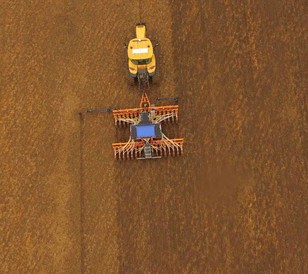
How one UK farm is beating black-grass

Up to the mid-1980s, growing a diverse rotation that included potatoes, sugar beet and maize for the farm’s store cattle, these spring-established crops – along with effective herbicide chemistry – kept a lid on the farm’s black-grass.
At that time, structural change to the business saw the rotation simplified to winter cereals and for a time, the effectiveness of isoproturon (IPU) maintained good grass-weed control across the farm’s medium to heavy soils.
IPU was banned in 2009 and coincided with a widespread decline in efficacy from post-emergence ALS-inhibiting herbicide products, such as Atlantis (iodosulfuron + mesosulfuron).
While the farm’s black-grass problem never became critical, Mr Mair says the business had the foresight to see that its current system may allow the problem to become much worse and render wheat production uneconomical.
After discussions with the farm’s agronomist Darren Hooker, from advisory group Agrii, a shift in management strategy to negate the threat was implemented.
Back to basics
With the farm’s worst black-grass patches on the heaviest and wettest soils, a drive for improving drainage was an important step in the right direction, including ditch maintenance and mole ploughing.
For ground preparation, a plough-press-drill system was in place, but the plough was abandoned in 2009 in favor of a min-till system, until the current low-disturbance regime was put in place.
The farm now uses a Tilso Rake and Roll pass immediately after harvest to encourage weed germination and followed by a low-disturbance sub-soiler to take out compaction. Any germinated black-grass is then sprayed off with glyphosate ahead of planting with the farm’s Ma/Ag no-till disc drill.
“We are keeping all the seed on the surface and it’s a low-disturbance drill, so shouldn’t stimulate much more black-grass to germinate,” explains Mr Mair.
Drill dates
In the days of IPU and effective post-emergence chemistry, the farm would kick-off winter wheat drilling in the first week of September, but it is now pushed back to late-October or early November.
Although a risky strategy and one that could see a proportion of the crop not make it into the ground, its latest 6m drill allows the 190ha of wheat to be drilled in four to five days.
This mitigates some of that risk, but if conditions dictate wheat can’t be drilled in the autumn, the farm’s area of spring crops – also introduced to negate black-grass – will be expanded in the New Year.
Spring barley, spring beans and spring oats – all for seed – are the more conventional options, joined by late spring-sown options canary seed and millet for bird feed, which offer an extended window for pre-drilling control with glyphosate.
Residual herbicides
Key to grass-weed control in Mr Mair’s winter wheat crops is a residual pre-emergence herbicide application of flufenacet, diflufenican, flurtamone and prosulfocarb.
This is delayed up to seven days if conditions are dry, allowing Mr Mair to wait for moisture to help get maximum efficacy out of the herbicides. Glyphosate is included in the mix if there is a further flush of weeds and the crop is yet to emerge.
A post-emergence treatment of iodosulfuron + mesosulfuron (Atlantis) is still used on select fields, but more for wild oat control than black-grass due to its more limited efficacy.
The implementation of low-disturbance establishment, delayed drilling and spring cropping, along with improved drainage and soil health, is shifting the system away from overreliance on this crucial chemistry to negate resistance and keep variable costs down.
Cover crops
In the future, Mr Mair is considering introducing cover crops into the rotation where there is black-grass. These will be grazed by sheep, reducing any potential seed return, and direct drilled with a cereal in the spring. Extra focus will also be put onto variety choice, maximizing crop competitiveness to smother grass-weeds.
He also hopes a derogation to allow autumn use of the nitrogen-based starter fertilizers applied in the spring might further boost crop competition, noting that nutrient leaching would be insignificant due to the minimal soil disturbance in his establishment system.
“Our system won’t work for everyone, but on our relatively small family farm we now feel like we are now on top of black-grass,” notes Mr Mair.
Image Gallery
Related Articles

How the Cazado® Launch Embodies Value Innovation

From Market, For Market: How Grower Feedback Drives Innovation

